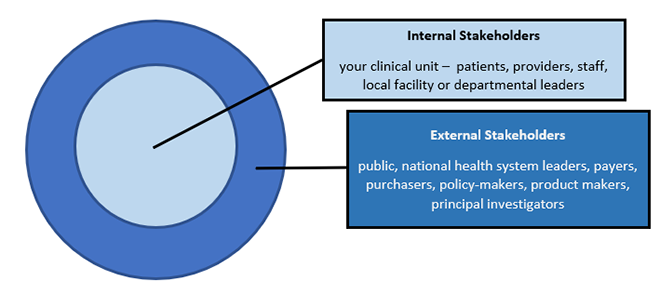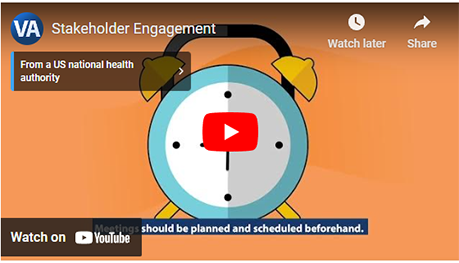Implementation and Adaptation Guide
Home | Table of Contents | Pre-Implementation | Implementation | Sustainment | Resources | Glossary | Contact Us

Stakeholder Engagement
A stakeholder is an individual or group who responsible for or affected by health- and healthcare related decisions. Identifying and engaging with stakeholders is important to the success of your program.
Engagement is the relationship between stakeholders and researchers, clinicians, or program staff. Engagement results in informed decision-making about selection, design, conduct, and uses of research. There is an increasing need for research to engage stakeholders if we want real-world impact.
Stakeholder engagement enhances:
- Research: It puts more ideas on the table than if the development and implementation were confined to a single organization or a small group of like-minded people.
- Relevance: It includes varied perspectives from all sectors and elements of the community affected, thus giving a clearer picture of the community context and potential pitfalls and assets.
- Trust: It increases ownership and buy-in and support for the program from all stakeholders by making them an integral part of its development, planning, implementation, and evaluation. It becomes their effort, and they’ll do their best to make it work.
- Credibility of your organization: Involving and attending to the concerns of all stakeholders establishes your organization as fair, ethical, and transparent, and makes it more likely that others will work with you in other circumstances.
- Mutual Learning: It saves you from being blindsided by concerns you didn’t know about or conducting a study that people aren’t interested in. If everyone has a seat at the table, concerns can be aired and resolved before they become stumbling blocks.
Who are stakeholders?
Stakeholders can be internal and external.

To identify stakeholders, you can use this modification of the 7Ps framework by Concannon. Following this framework, stakeholders include:
- Patient and the public
- Providers: individuals and organizations that provide care to patients and populations
- Purchasers: employers, self-insured, government and other entities responsible for underwriting costs of health care
- Payers: insurers, Medicare and Medicaid insurance exchanges, individuals w/deductibles, and others responsible for reimbursement for interventions and episodes of care
- Policy makers: White House, Dept of health and human services, congress, states, professional associations, intermediaries, and other policy-making entities
- Product makers: drug and device manufacturers
- Principal investigators: other researchers and their funders
To this list we add:
- Staff
- Local facility or departmental leaders
- Health system leaders
You may not need to engage all of these stakeholders for all projects. Also, who is engaged can vary over time.
How to Identify Stakeholders
In identifying stakeholders, think beyond the obvious. Some stakeholders are harder to see. Try to think of as many ways as possible that your effort might bring benefits or problems to people not directly in its path. Use one or more of the following ways to identify stakeholders:
- Brainstorm
- Gather people in your organization already involved in the effort and start calling out categories and names. Say anything that comes to mind. After 10 or 15 minutes, stop and discuss each suggestion.
- Collect
- Collect categories and names from informants in the community, particularly members of the population of concern.
- Consult
- Consult with organizations that have been involved in similar efforts, or that work with the population.
- Ideas
- Get more ideas from stakeholders as you identify them.
Engagement strategies
Once you have identified stakeholders, you can gather their input through a variety of methods:
- Focus Groups
- Community Advisory Boards
- Usability testing
- Regular site check-ins
- Annual in-person team meetings
- Virtual coffee meetings
- Surveys/Qualitative interviews
Use the Stakeholder Engagement Worksheet to consider your stakeholders and how you will engage them.
Download the Stakeholder Identification worksheet
Explore Resource page for more.
Return to: Setting Up a Program For Success / Next: Keys to Successful Implementation




















